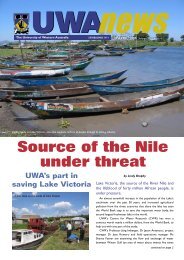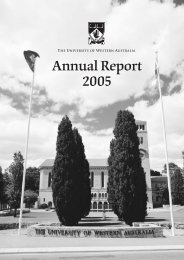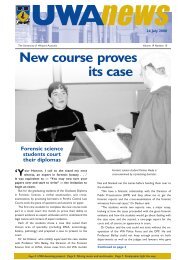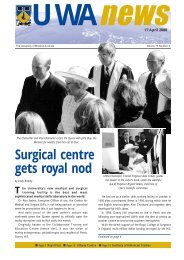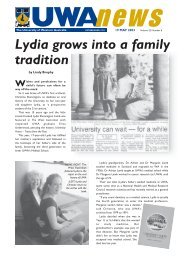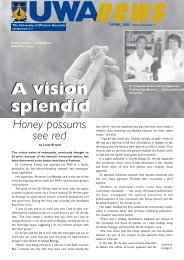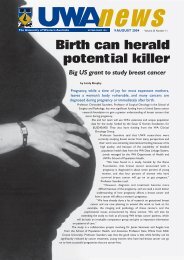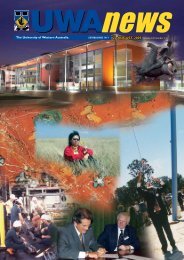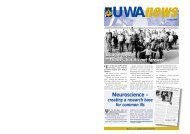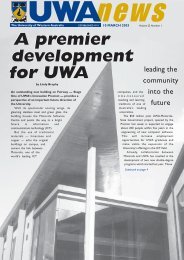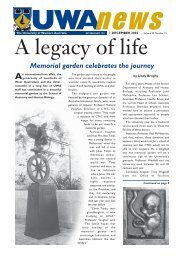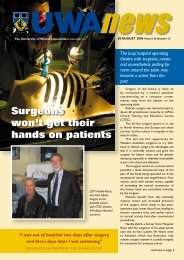New test to ease pain for liver patients - UWA News staff magazine
New test to ease pain for liver patients - UWA News staff magazine
New test to ease pain for liver patients - UWA News staff magazine
- No tags were found...
Create successful ePaper yourself
Turn your PDF publications into a flip-book with our unique Google optimized e-Paper software.
<strong>UWA</strong>news 3Kaye’spassionrewardedKaye De Pardo sitting insidea section of pipe from theNorth West Shelf<strong>UWA</strong> graduate Kaye De Pardohas won the 2006 WA youngEngineers of the year Award.Kaye, who completed a doubledegree in engineering and commerce at<strong>UWA</strong> be<strong>for</strong>e graduating with honoursin engineering in 2002, won the award<strong>for</strong> enthusiastically devoting herself<strong>to</strong> the promotion of engineering asa dynamic profession <strong>to</strong> other youngengineers and potential engineers ofthe future.She was recruited by Woodsidebe<strong>for</strong>e graduating as an electrical engineer.Her first job after joining Woodside was<strong>to</strong> jump on a plane and head <strong>to</strong> Karratha,where she worked on the constructionof train four of the liquefied natural gasplant.“It was an eyeopeningexperience<strong>for</strong> a g r a d u a t estraight out of uni.There I was thinkingI was going <strong>to</strong> beworking in an offi ce so I’d bought myfi rst suit but instead I was working on adirty gas plant wearing steel cap boots.“At uni it’s very different becauseyou learn so much theory but up thereI was able <strong>to</strong> learn so much and seeso many things. Because I was on aconstruction site, I could see all the bitsand pieces that make up the genera<strong>to</strong>r.“As the construction electricalengineer, my role was <strong>to</strong> overview whatwas being constructed and make sure itwas being done <strong>to</strong> Woodside’s standards.“I was in charge of looking aftersmall projects being constructedthrough <strong>to</strong> commissioning, and <strong>test</strong>ingthem <strong>to</strong> make sure they worked.”After two years in Karratha, Kayereturned <strong>to</strong> Perth <strong>to</strong> work in theoffshore operations group, on projectssuch as North Rankin A, Goodwyn Aand Cossack Pioneer.“It was great <strong>to</strong> get out and havea few years experience on site be<strong>for</strong>ecoming back in<strong>to</strong> the offi ce because itgives you a much better understandingof why we do things a certain way andwhy strict standards are needed.”Kaye is currently working on theAngel Gas Project, a new plat<strong>for</strong>mbeing built on the North West Shelf.“It will be a not-normally-mannedplat<strong>for</strong>m, so there won’t be any“We thank doc<strong>to</strong>rs <strong>for</strong> saving our lives butwe <strong>for</strong>get they’re using a piece of equipmentthat has been designed by an engineer.”people living and working on it, but acrew will go out every six weeks <strong>for</strong>maintenance. It’s being powered fromthe North Rankin A through a 55kmextension cord and is expected <strong>to</strong> beoperational by early 2008.“The legs are being built in Chinaand the <strong>to</strong>p part is being built inMalaysia so I will go <strong>to</strong> Malaysia <strong>to</strong>commission the <strong>to</strong>p be<strong>for</strong>e it’s fl oateddown here. It’s great <strong>to</strong> be involved inthe whole project from start <strong>to</strong> fi nish.”Kaye has been involved in theYoung Engineers Committee since shewas fi rst introduced at <strong>UWA</strong> in 1998.THE UNIVERSITY OF WESTERN AUSTRALIA • 23 OCTOBER 2006“Young Engineers has grown a lot– when I was first involved, it was just asundowner event with a few companiesinvolved and now we have lots ofcompanies involved and it’s a major event.“I’ve seen it grow and I can’t helpbut feel proud <strong>to</strong> have been part ofthat. I keep in <strong>to</strong>uch with the chairof the committee <strong>to</strong> see how they’regoing and offer advice.Kaye was also involved in startingup the Engineering AmbassadorsProgram, which promotes engineering<strong>to</strong> high school students.“It involves going out <strong>to</strong> schoolsand talking about the opportunitiesin engineering so I tried <strong>to</strong> makemy presentations exciting,” she said.“The hardest part istrying <strong>to</strong> relate <strong>to</strong> 15-year-olds, use terminologythey can understand andmake engineering soundexciting and that it hasgreat opportunities.“I tell them there are manydifferent fi elds of engineering, includingrisk engineering and cost engineeringand engineers work at every level, rightup <strong>to</strong> CEO level.“I want <strong>to</strong> put engineering out atthe <strong>for</strong>efront in the community becausewe <strong>for</strong>get how important engineers are– they are involved in many aspects ofour lives.“We thank doc<strong>to</strong>rs <strong>for</strong> saving ourlives but we <strong>for</strong>get they’re using a pieceof equipment that has been designed byan engineer. There’s a lot more we cando <strong>to</strong> promote the profession.”
<strong>UWA</strong>newsSupport ameasureof trustin <strong>UWA</strong>’sfutureT h e r e c e n t l a u n c h i nW i n t h r o p H a l l o f t h eUniversity’s $25 millionBusiness School fundraisingcampaign has revealed thesubstantial level of support<strong>for</strong> the future of <strong>UWA</strong> withinthe community at large.We have been overwhelmed bythe level of belief and the degreeof commitment of so many people<strong>to</strong>wards ensuring that The Universityof Western Australia continues <strong>to</strong>build a sound future <strong>for</strong> the benefit ofall West Australians.The campaign has already securedmore than $11.5 million, or morethan 45 per cent of its goal, includingsignificant contributions fromWoodside Limited and Wesfarmers.We have also received substantialsupport from many other corporatesponsors and individuals.The funding will be used <strong>to</strong>develop initiatives designed <strong>to</strong>retain talented students in WesternAustralia reflecting the desire ofdonors, sponsors and the University<strong>to</strong> develop multi-skilled graduateswith integrity, leadership and academicability. The campaign funding will alsoprovide support <strong>for</strong> endowed chairs,scholarships, visiting fellows, andguest lecture series and complementconstruction of the new worldclass Business School building at thesouthern end of campus.The almost 50 sponsorships,pledges, and donations made <strong>to</strong> thecampaign are significant in that theyindicate a measure of trust in thefuture of our University which wasVice-Chancellor’scolumnestablished in 1911 and boostedby the significant gift of Sir JohnWinthrop Hackett.Leadership, not only by ourChancellor, Business School Board andExecutive, but also by the fundraisingcampaign volunteers and majordonors, including corporate, alumni,and friends of the University in theinitial stages of the campaign, hasmade all the difference.We are truly encouraged bythe initial and enthusiastic support<strong>for</strong> the University and its goals. Thecampaign provides a focus <strong>for</strong> all ofus in an exciting period of growthand enrichment <strong>for</strong> the BusinessSchool, which aims <strong>to</strong> remain botheducationally relevant and increasinglycompetitive internationally.There is no doubt that thesignificant contribution <strong>to</strong>wards theendowment of a Woodside Chair ofManagement and Leadership and themajor contribution of Wesfarmers willstrengthen the relationships betweenour organisations as we each seek <strong>to</strong>consolidate and grow our activitiesboth within Australia and across theglobe.The launch has been a positiveand exciting start <strong>to</strong> a campaign thatcould well become the model ofour ef<strong>for</strong>ts <strong>to</strong> diversify our incomestreams in the future.Alan RobsonVice-ChancellorProfessor Holmanwins <strong>to</strong>p publichealth awardProfessor D’Arcy Holmanhas become the first WestAustralian <strong>to</strong> win Australia’smost prestigious public healthaward.Professor Holman, who is Professorof Public Health at <strong>UWA</strong>, was lastmonth awarded the Sidney Sax PublicHealth Medal.The medal is awarded annually bythe Public Health Association <strong>to</strong> anindividual deemed <strong>to</strong> have made anoutstanding contribution <strong>to</strong> promotingand protecting the health of thecommunity.The Sidney Sax Public Health Medalwas first awarded <strong>to</strong> Dr Neal Blewettin 2000 <strong>for</strong> his contribution as federalhealth minister.The award citation said ProfessorHolman had been highly regardednationally and internationally <strong>for</strong> hispublic health work over many years.Professor Holman graduatedin medicine from <strong>UWA</strong> in 1979 andshortly after, received a postdoc<strong>to</strong>ralresearch training fellowship from theInternational Agency <strong>for</strong> Research onCancer. This enabled him <strong>to</strong> receiveadvanced training at Harvard University,from which he graduated with a Masterof Public Health with distinction.Since returning <strong>to</strong> Perth, ProfessorHolman held senior positions at theHealth Department be<strong>for</strong>e joining theacademic <strong>staff</strong> at <strong>UWA</strong> in 1992.THE UNIVERSITY OF WESTERN AUSTRALIA • 23 OCTOBER 2006
<strong>UWA</strong>news 5TowardsbettersnakebitetreatmentAustralia records up <strong>to</strong> 3,000snakebites a year, most causedby brown snakes and whilevictims can be treated withanti-venom, recent researchsuggests that it is not alwayseffective.Kathleen Davern (pictured right),of the Western Australian Institute <strong>for</strong>Medical Research (WAIMR) believesone reason could be that brown snakesfrom different parts of the country mayhave different venom.“In other words, the anti-venomthat works on snakes in south-easternAustralia may not work as effectively onbrown snakes in WA or Queensland.”The brown snakes genus includesthe dugite, gwardar and eastern brownsnake.Ms Davern, who heads WAIMR’sMonoclonal Antibody Facility, is cosupervisingTammy Jacoby, who isstudying <strong>for</strong> her MSc/PhD throughWAIMR and the Centre <strong>for</strong> ForensicMedicine at <strong>UWA</strong>.Tammy’s research will follow upon a 2005 study, which found thatbrown snake anti-venom did notalways neutralise the proteins, or <strong>to</strong>xiccomponents, in the venom.By comparing brown snake venomfrom different parts of the countrythey hope <strong>to</strong> develop more effectivetreatment <strong>for</strong> snakebites. “We canalready see that there is a differencebetween the venom of western andeastern snakes,” Ms Davern said. “Thequestion is: can we make anti-venomthat would give us broader coverage?“We are looking <strong>for</strong> antibodies<strong>to</strong> block components in the venomthat may not be being blocked. If it ispossible <strong>to</strong> get pure antibodies thatwill react with one component in thevenom, we will then know that if itblocks the component now it will blockit in the same way in 10 years or in 50years.”With time a crucial fac<strong>to</strong>r intreating snakebites, Ms Davern ishopeful the research may also helpimprove and speed up diagnosis. “Then,if you don’t know which snake bit you,a blood <strong>test</strong> could be done <strong>to</strong> identifythe <strong>to</strong>xins in the blood and identify thesnake,” she said. “We may even be able<strong>to</strong> go further and say the <strong>to</strong>xin is froma brown snake with components a, c, dand x. Then we can target those specifi ccomponents.”In Australia every year, up <strong>to</strong> 500cases of snakebite need anti-venomtreatment, and more deaths are causedby brown snake venom than by anyother, because brown snakes arewidespread and their venom is highly<strong>to</strong>xic. “They can also inject multipledoses of venom,” Ms Davern said. “Theinland taipan is the most deadly snakebut because of its distribution it is farless likely <strong>to</strong> be encountered.”If broader spectrum anti-venomcan be developed, could the researchbe applied <strong>to</strong> other snake venom?Ms Davern believes it could. “We arecurrently having discussions with theMenzies School of Health Researchin Darwin and the <strong>New</strong>castle MaterHospital about research in<strong>to</strong> the deathadder, tiger snakes and possibly thetaipan,” she said.The scope of the study couldalso be broadened <strong>to</strong> search <strong>for</strong>antibodies <strong>to</strong> treat victims of Asiansnakes. “In Sri Lanka, <strong>for</strong> example, lotsof people are bitten by snakes and theantibodies currently available are notvery effective,” Ms Davern said.The venom of brown snakescontains deadly neuro-<strong>to</strong>xins thataffect the brain and nervous system,causing <strong>pain</strong> and severe headaches.Some components attack the blood,causing it <strong>to</strong> clot, while others thin theblood. But, as Ms Davern is quick <strong>to</strong>stress, most snakes are as anxious <strong>to</strong>avoid human contact as we are <strong>to</strong> keepout of their way. If left alone, they areunlikely <strong>to</strong> attack.THE UNIVERSITY OF WESTERN AUSTRALIA • 23 OCTOBER 2006
<strong>UWA</strong>newsLifting thelid on genesProfessor AlanRobson, StuartPearse andProfessor HansLambers, School ofPlant Biology (L-R)The potential <strong>for</strong> genetic andstem cell research <strong>to</strong> helpward off common dis<strong>ease</strong>swill be the focus of a freeseminar <strong>to</strong> be held at theUniversity Club of WA onTuesday 24 Oc<strong>to</strong>ber.Professor Peter Klinken, headof the WA Institute <strong>for</strong> MedicalResearch (WAIMR) said the seminar,The Impact of the Genomic Era onSociety, would lift the lid on futurepossibilities of genetic and stem cellresearch.“Understanding the geneticcauses of conditions including skincancer, heart dis<strong>ease</strong> and diabetesis critical <strong>to</strong> improving our health– and holds the potential <strong>to</strong> be able<strong>to</strong> predict what dis<strong>ease</strong>s a personmay develop,” Professor Klinken said.“This sort of research reallyopens up a world of opportunities<strong>to</strong> be able <strong>to</strong> then hopefully takepreventative actions and possiblys<strong>to</strong>p a person developing a lifethreateningcondition.“The implications of such afuture on the health system, andof course on individuals, are whatwe will be looking at as part of thisseminar.”Keynote speakers will beProfessor John Shine, direc<strong>to</strong>r ofthe Garvan Institute <strong>for</strong> MedicalResearch in Sydney and ProfessorJohn Funder, <strong>for</strong>mer head of theBaker Heart Research Institute inMelbourne.The Lotterywest seminar isfree but bookings are essential. CallWAIMR on 9224 0333 <strong>to</strong> book.Scholarshipshelp students <strong>for</strong>gecloser ties with AsiaSix <strong>UWA</strong> students wereawarded scholarships <strong>to</strong> studyin Asia in 2005-06 while af u r t h e r s eve n s t u d e n t sfrom Asian universities wonscholarships <strong>to</strong> study at <strong>UWA</strong>over the same period.The $7.5 million EndeavourAustralia Cheung Kong ScholarshipsProgram is a joint initiative between theCheung Kong Group and the FederalGovernment.The <strong>UWA</strong> winners and those fromother WA universities were recognisedat a reception held at the <strong>UWA</strong> Clublast month.Federal Education Minister JulieBishop and Vice Chancellor AlanRobson joined the group managingdirec<strong>to</strong>r of Cheung Kong Industries, MrHL Kam and Chairman of CitiPower,Powercor Australia and ETSA Utitlities,Mr Peter Tulloch, <strong>to</strong> congratulate thescholarship recipients.Stuart Pearse, from the Schoolof Plant Biology, who won thepostgraduate award, also spoke abouthis experiences.<strong>UWA</strong> undergraduate scholarshipawardees were Sherman Hau Cho Lo,Annabel Yuk Mei Lai, Pamela Currie,David Modolo and Dorcas Chia.Professor Robson said thescholarship program had done much<strong>to</strong> link Australian universities and<strong>to</strong>p students with their counterpartsthroughout Asia.As well as highlighting the talents ofstudents, the program had also served<strong>to</strong> showcase <strong>UWA</strong> <strong>to</strong> the region, hesaid.“This benefit has been reciprocatedwith an outstanding array of Asianstudents travelling here <strong>to</strong> study,”Professor Robson said.With the support of the FederalGovernment, the scholarship programwas established in 2004 <strong>to</strong> facilitateeducational exchange between Australiaand Asia.Originally planned as a threeyearinitiative <strong>for</strong> undergraduate andpostgraduate students, the program hasbeen extended <strong>to</strong> five years followingtremendous feedback.The funds have been reallocated <strong>to</strong>support 200 undergraduate exchangesand 20 postgraduate scholarships eachyear.Almost 1,000 students will benefitfrom the <strong>to</strong>tal $7.5 million funding overfive years.The Cheung Kong Group is a HongKong-based company that operates in54 countries and employs more than220,000 <strong>staff</strong> worldwide.As one of the biggest <strong>for</strong>eigninves<strong>to</strong>rs in Australia, it has interestsin energy, transport and infrastructure,life sciences and eco-agriculture, watertreatment and telecommunications.THE UNIVERSITY OF WESTERN AUSTRALIA • 23 OCTOBER 2006
Landscapecomes first inurban designproject<strong>UWA</strong>newsInnovation on the design of suburbia is veryhard <strong>to</strong> achieve but after three years’ hardwork, the landscape architecture <strong>staff</strong> at <strong>UWA</strong>have had some success.On Oc<strong>to</strong>ber 18 Planning Minister Alannah MacTiernanofficially launched the masterplan <strong>for</strong> Wungong Urban Water.The1500ha site will house 40,000 people near Armadalein Perth’s South East – a project initiated by a landscapestructure plan by the <strong>UWA</strong> landscape architects and one<strong>to</strong>uted <strong>to</strong> set a new level <strong>for</strong> suburban design in Australia.Generally, suburbs are ruled up with scant regard <strong>to</strong> theexisting landscape or larger ecological systems in<strong>to</strong> whichthey fit. This is particularly so in Perth where the sandy<strong>to</strong>pography is easy <strong>to</strong> erase and the common vegetation,despite being part of one of the world’s most biodiverseplaces, is still widely perceived as “scrub”.Understandably, developers also want <strong>to</strong> maximise theirreturn, which means maximising the number of lots they canget out of a given site. Additionally, ecological concerns do notalways translate in <strong>to</strong> the picturesque and sanitised qualitiesmany consumers expect from a new suburb. But WungongUrban Water could change all that.In 2004 Professor Richard Weller and Lecturer TinkaSack, of the <strong>UWA</strong> Landscape architecture program, wereinvited by the Armadale Redevelopment Authority (ARA) <strong>to</strong>prepare the first conceptual plan <strong>for</strong> the project.Reflecting on the long and complex process since thatfirst design, Professor Weller said the original ideas werestrong enough <strong>to</strong> survive the process but the client andproject managers were also genuinely enlightened aboutenvironmental values.The ARA gave the landscape architects the opportunityof showing how a whole suburb could be reconfigured <strong>to</strong> fitthe landscape, whereas the norm is <strong>for</strong> the landscape <strong>to</strong> bereconfigured <strong>to</strong> fit a suburb.The main idea that distinguishes this development fromother suburban models is that the whole project is organisedaround a network of linear public open space. This networkincludes revegetated riparian zones, wetlands, bushland andindigenous (archaeological) sites.Binding these existing landscapes <strong>to</strong>gether is the idea ofthe park avenues, 30 metre wide strips of land planted withfour rows of Eucalypts that repeat across the whole project.The avenues also define the public open space matrixof the suburb and not only allow, but encourage pedestrianmovement. They provide a unique landscape character, <strong>for</strong>mwildlife corridors and mitigate against harsh easterly windssoaring down off the scarp.Most importantly, in this low-lying site, the avenues framedrainage lines. Each avenue captures, conducts and cleans thes<strong>to</strong>rm water as it makes its way <strong>to</strong>ward the Wungong River,which runs through the middle of the suburb and feeds in<strong>to</strong>the Canning River.The <strong>UWA</strong> landscape architecture team might have hadsome good simple ideas <strong>to</strong> start the ball rolling, but ProfessorWeller is keen <strong>to</strong> point out that 64 people from 38 differen<strong>to</strong>rganisations have been responsible <strong>for</strong> the evolution of thisproject.And they include local urban designers The PlanningGroup and Project Direc<strong>to</strong>r Matt Taylor from CSIRO. CSIROhas made the project a part of its national research programWater <strong>for</strong> a Healthy Country Flagship.“This project demonstrates that the three tiers ofgovernment, academics and corporate firms can come<strong>to</strong>gether <strong>to</strong> produce a better product when there is a truesustainability agenda, trust and integrity,” Mr Taylor said.THE UNIVERSITY OF WESTERN AUSTRALIA • 23 OCTOBER 2006
a series ofartworks<strong>UWA</strong>newsWorks by acclaimed West Australian artistsRobert Juniper, Miriam Stannage and EvelineKotai feature in the Lawrence Wilson ArtGallery’s la<strong>test</strong> exhibition.One thing after another: sets and series in Australian artis the title of the exhibition, which runs until December12.Covering five decades of Australian art, the exhibitionis both an overview of the work of many Australianartists and a precise look at facets of their particularworking methods.During the exhibition, the gallery will run three talksand <strong>to</strong>urs, providing the opportunity <strong>to</strong> trace some of theartists’ pathways and gain a greater sense of the originsand development of their ideas.The <strong>to</strong>urs and talks are free and <strong>for</strong> more details, callthe gallery on 6488 3707 or visit www.Lwgallery.uwa.edu.auTHE UNIVERSITY OF WESTERN AUSTRALIA • 23 OCTOBER 2006
Law andmentalharm bookupdated<strong>UWA</strong>news 9by Maureen de la HarpeM o s t A u s t r a l i a n s wo u l dremember the 1986 tragedyin outback WA when 16-yearoldsJames Annetts and SimonAmos died in the desert, andthe courts later found theiremployer guilty of negligence.James Annetts’ parents sought– and eventually won – damages <strong>for</strong> thesuffering they endured through beingin<strong>for</strong>med of their son’s disappearanceby telephone at their Sydney home.While the parents suffered nophysical injury; their suffering waspsychological, or what is known in legalterms as “mental harm”. And it is thisaspect of the law that is the focus of anew book by Professor Peter Hand<strong>for</strong>dof the School of Law.Tort Liability <strong>for</strong> Psychiatric Damage,published by Lawbook Co (a divisionof Thomson Publishers) and rel<strong>ease</strong>d inJune this year, is the second edition of abook originally co-authored with Perthbarrister Nicholas Mullany, which waspublished in 1993. Professor Hand<strong>for</strong>dhas written the new edition, which istwice as long as the original.In the book he discusses legalliability in cases where damages aresought by people claiming <strong>to</strong> havesuffered mental harm. In the Annettscase, James’ parents had <strong>to</strong> take theircase as far as the High Court, which– in 2002 – ruled that their son’semployer owed a duty of care <strong>to</strong> them.(The parties subsequently agreed onthe terms of a settlement.).“The action taken by the parentsbecame a leading case in Australia,”Prof Hand<strong>for</strong>d said. “A similar case inthe UK concerned action taken byrelatives of people killed or injuredin the Hillsborough football stadiumdisaster in Yorkshire in 1989.”Mental harm can result from arange of situations in which an individualsuffers through the carelessness ofanother. In the fi rst edition, which waswidely cited by courts in a number ofcountries besides Australia, includingthe House of Lords in the UK, andSouth Africa’s Supreme Court ofAppeal, the authors argued that thescope of the law should be widened<strong>to</strong> cover more cases in which plaintiffscould be awarded damages.“In the interim, there have beendevelopments in the law and a numberof changes have been made, so thebook may have had something <strong>to</strong>do with the changes,” said ProfessorHand<strong>for</strong>d. “Today Australian law is muchmore in favour of plaintiffs, thoughthe civil liability legislation of 2002 haspossibly limited the scope of the caselaw developments. Changes have alsobeen made in England, but not as manyas here. So differences in law betweendifferent countries have opened up.”The scope of the book isinternational – spanning the laws ofAustralia, Britain, Canada, the US, <strong>New</strong>Zealand, and South Africa. This edition,like the previous one, contains a<strong>for</strong>eword by Lord Bingham of Cornhill,presiding judge of the House of Lords.The book can be ordered byphone (1300 304 195), or by email:LRA.Service@thomson.com.Seminar tackles big issuesHigh Court Judge Michael Kirby and <strong>for</strong>mer WA ChiefJustice David Malcolm are among the speakers at this week’sinternational seminar on globalisation, law and justice.The seminar will be held this Friday, Oc<strong>to</strong>ber 27 and Saturday, Oc<strong>to</strong>ber 28,at the University Club and offers a rare opportunity <strong>to</strong> hear from prominentthinkers around the world.Leading legal authorities will explore the fundamental issues at the core ofthe internationalisation of law movement.International speakers include Dr Sam Muller, Direc<strong>to</strong>r of Hague Institute <strong>for</strong>the Internationalisation of Law, and Professor Michiel Scheltema, Professor of Lawat Leiden University in Holland.To register call 6488 2433 or visit www.extension.uwa.edu.auTHE UNIVERSITY OF WESTERN AUSTRALIA • 23 OCTOBER 2006
10 <strong>UWA</strong>newsThe religion of sportby Simone HewettSport is often referred <strong>to</strong> as areligion in Australia and CanonReverend Richard Pengelleyis keen <strong>to</strong> explore the linksbetween the two in a new unitcalled Sport and Spirituality, inthe School of Human Movementand Exercise Science.As an ordained Anglican priest and<strong>for</strong>mer elite sportsman, the course neatlycombines his two areas of interest.Richard represented Australia inwater polo at the 1984 and 1988 OlympicGames and has also coached the <strong>UWA</strong>Perth Torpedoes water polo team.After completing a Bachelor ofPhysical Education and Diploma ofEducation at <strong>UWA</strong>, he became aphysical education teacher.Richard then obtained a Bachelorof Divinity from Murdoch Universitybe<strong>for</strong>e his ordination as an Anglicanpriest.He worked as a parish priest atSt Nicholas in Carine/Duncraig be<strong>for</strong>ebecoming chaplainat Hale Schooland in Novemberlast year joined StGeorge’s College aschaplain and beganlecturing in the School of HumanMovement.“As a Christian elite sportsman,I have had the experience of meetingmany religious sports people,” he said.“Not many people realise it, but atevery Olympic Games village, there’sa chapel and a mosque and you won’tfind an American sporting team withouta chaplain.”But he was quick <strong>to</strong> point out thatthe new unit would not be faith-based.“What I want <strong>to</strong> do is with this unitis explore the his<strong>to</strong>rical connection,” hesaid. For example, the ancient OlympicGames were quite a religious experienceinvolving the worship of gods.“More time was devoted <strong>to</strong> ethicstraining than sports training – therewas even a wreath <strong>for</strong> the athlete whocompeted with the best ethics.”Richard also pointed out thefounder of the modern Olympic Games,Baron de Coubertin, was Catholic,Lecturer and chaplain Richard Pengelley in his office at the School of Human Movementwhile hymns were a feature of theopening ceremony and many athleteswent <strong>to</strong> church.“In the 19th century sports clubsand sporting committees began <strong>to</strong>spring up around workplaces, so youhad the YMCAs and churches offeringsports clubs,” he said.“In the late 19th century and early20th century, sport and Christianitybecame more closely linked as a healthyway of life.”Richard said while it was important<strong>to</strong> have a healthy mind and body, the“In Australia, we go <strong>to</strong> extreme lengths <strong>to</strong> worshipthese heroes and gods of the sporting world”role of the spirit was also significant.“In Australia, we go <strong>to</strong> extremelengths <strong>to</strong> worship these heroes andgods of the sporting world, so I want<strong>to</strong> examine the symbolism of heroes,banners and team colours and therituals that go with supporting a team,”he said.“Going <strong>to</strong> the football has becomea cultural event – you dress up in theteam colours and sing hymns <strong>to</strong> yourheroes; they run out on <strong>to</strong> the fieldthrough a banner and you suspendreality <strong>for</strong> a few hours.“The euphoria of 40,000 peoplecheering when their team wins and thefeeling of devastation when they lose– it’s all part of the event.”He said the unit would investigatethe media’s role in creating heroes andmyths surrounding sport and sportspeople.“There’s frequent use of religiousmetaphors in sports reporting but whydo these metaphors work so well whenTHE UNIVERSITY OF WESTERN AUSTRALIA • 23 OCTOBER 2006most people don’t know the origin?The course will also examine thepsychology of belief systems in athletes,he said.“Many elite team athletes huntin packs and are taught <strong>to</strong> ‘kill’ butthen they are expected <strong>to</strong> be fine,upstanding, moral citizens off the field,”he said.“It can be difficult <strong>for</strong> them <strong>to</strong> dothat when they don’t have a moralframework <strong>for</strong> their behaviour.”Richard said religion and sport didnot always go well <strong>to</strong>gether, becausethere could bea clash betweenvalues.“As a Christian,you aretaught <strong>to</strong> turn the other cheek and<strong>to</strong> let the other person go first, <strong>to</strong>sacrifice yourself <strong>for</strong> others,” he said.“But sport teaches the opposite– it’s the only area where societyactually sanctions violence, and violenceis expected.“Where there’s a clash betweenreligion and sport, sport always wins.”Richard said the underlyingquestion was whether sport could bea religion.“Does sport contain all thecomponents <strong>to</strong> be considered as arealistic replacement <strong>for</strong> religion in ourlives,” he said.“Most theologians would say nobut some sociologists would say that<strong>for</strong> some people, <strong>for</strong> short periods oftime, it does, with its tribal aspects,hero worship and prayers.”Sport and Spirituality will initiallybe offered as a third year elective inthe School of Human Movement andExercise Science.
<strong>UWA</strong>news 11The Lung Institute of Western Australia(<strong>for</strong>merly known as the Asthma & Allergy Research Institute)is now seeking applications <strong>for</strong> the following:Summer Undergraduate CadetshipsFull-time medical and science undergraduate students are invited <strong>to</strong> apply <strong>for</strong>the LIWA Summer Vacation Research Cadetship programme.programme is aimed at students interested in learning about medical andscientific research and undertaking a supervised research project.A tax-free scholarship of $400 per week <strong>for</strong> up <strong>to</strong> 10 weeks full time work isoffered <strong>to</strong> successful candidates. Students may be offered part-timeemployment on completion of the programme. Several cadetships areavailable.PhD Top Up ScholarshipsLIWA offers PhD Top Up Scholarships <strong>to</strong> students with outstandingundergraduate records who attract Australian Postgraduate Awards orequivalent scholarships.Students are encouraged <strong>to</strong> apply <strong>for</strong> supplementary awards valued in thefirst year at $7000 per annum with subsequent annual incr<strong>ease</strong>s <strong>to</strong> <strong>to</strong>p up theirincome <strong>for</strong> the duration of their research studies with LIWA.TheUp <strong>to</strong> fivescholarships are available, including at least one in the field of genetics andone in the field of air quality and lung health.The awards are open <strong>to</strong> applicants across Australia who intend <strong>to</strong> enrol at theUniversity of Western Australia.For further in<strong>for</strong>mation on either of these programmes and application <strong>for</strong>ms: Visit http://www.aari.uwa.edu.au/careers/students Phone Pam McManus on 08 9346 3198 Email admin@liwa.uwa.edu.auApplications <strong>for</strong> the 2007 Cadetship & PhD Scholarship programmeclose on 31st Oc<strong>to</strong>ber 2006 at 5pm.OUR DRYINGCLIMATELECTURE SERIES 2006FREE LECTURE TOMORROW AT 6PMCLIMATE CHANGE: MENACE, MYTH OR CONSPIRACY?The recent rel<strong>ease</strong> of Hollywood movies such as“An Inconvenient Truth” (2006) has raised communityinterest in the way our actions affect climate change. Atthe same time, debate rages between experts about thecredibility of the scientific basis of these films.In the fifth public <strong>for</strong>um of the Our Drying Climate LectureSeries, CSIRO’s Dr Bryson Bates will provide an exper<strong>to</strong>verview of the climate change debate, and will share whathas been learnt about the drying climate of the south wes<strong>to</strong>f Western Australia through the Indian Ocean ClimateInitiative. The event will be facilitated by Geraldine Mellet.FREE LECTURETOMORROW: TUESDAY 24 OCTOBER 2006, 6.00PM,OCTAGON THEATRE, UNIVERSITY OF WESTERN AUSTRALIARegister your interest <strong>to</strong> felicity@impcom.com.au or 9227 0956,or visit www.watercorporation.com.au <strong>for</strong> more details.WSP20103The Lung Institute of Western Australia (Inc).Ground floor E Block, Sir Charles Gairdner Hospital , Hospital Avenue, Nedlands WA, 6009Ph: 08 9346 3198 email: admin@liwa.uwa.edu.au www.aari.uwa.edu.auWSP20103-QtrPage <strong>UWA</strong> PRESS.indd 112/10/06 4:26:30 PMWHaTyOUSTaRTWiTH COUnTSTaKiNG THe PLUNGe iNTO THePROPeRTY MaRKeT?OUR SMART STARTHOME LOAN GIVES YOUA CLEAR ADVANTAGE.6.0 % pafi xed <strong>for</strong> 12 months7.1 % pa *comparison rateAs a first time home buyer, youCAN get in<strong>to</strong> the market with afantastic LOW INTRODUCTORYRATE that’s locked in <strong>for</strong> 12months - so you don’t feel thefinancial ripples of rate rises oradditional costs.LaP UP THe SaViNGS• Low intro rate <strong>for</strong> 12 months• Great ongoing variable rate• NO ongoing fees• NO annual loan fees• LOW establishment costCall a UnicreditLending Consultant<strong>to</strong>day on 9389 1011.LOaNS THaT UNDeRSTaND LIFe.* Smart Start rate valid until Sept 30 2006, applicable <strong>for</strong> the first 12 months of the loan be<strong>for</strong>e reverting <strong>to</strong> the standard variable rate. Early termination fees may apply.Comparison rate subject <strong>to</strong> change with market rates. Comparison rates are <strong>for</strong> loans of $150,000 <strong>for</strong> a term of 25 years. WARNING: This comparison rate is true only <strong>for</strong> theexamples given and may not include all fees and charges. Different terms, fees or other loan amounts might result in a different comparison rate. Fees, charges, terms, conditions& normal lending criteria apply. Pl<strong>ease</strong> refer <strong>to</strong> our Fees and Charges Schedule, available from any Unicredit branch. The University Credit Society Ltd. ABN 90 087 651 901.AFSL Number 244168.THE UNIVERSITY OF WESTERN AUSTRALIA • 23 OCTOBER 2006
<strong>UWA</strong>news 13NOTICEs2006 Distinguished Teaching andLearning Award <strong>for</strong> SchoolsCall <strong>for</strong> SubmissionsThe aim of this prestigious biennial Award is <strong>to</strong> encourage, promote andreward excellence in teaching and learning at the school level. It is awardedon the basis of a School’s teaching and learning portfolio judged by an expertpanel established by the Teaching and Learning Committee. The Award bringswith it funding <strong>for</strong> the appointment of a 0.5 <strong>staff</strong> member at the equivalent ofa Lecturer Level B <strong>for</strong> 12 months.All schools are encouraged <strong>to</strong> submit a teaching portfolio.Guidelines can be found at http://www.teachingandlearning.uwa.edu.au/page/74872The deadline <strong>for</strong> submissions is 31 January 2007.Professor Kathleen E. MahoneyProfessor of Law, The University of Calgary, CanadaRes<strong>to</strong>rative Justice, TruthCommissions, Commemoration —The aftermath of settlement societies in Canada andAustraliaMonday, 23 Oc<strong>to</strong>ber 2006 at 6pmGeography Lecture Theatre 1, <strong>UWA</strong>Kathleen Mahoney has been a Professor of Law at The University of Calgary<strong>for</strong> 18 years. She has law degrees from The University of British Columbia,and Cambridge University and a Diploma from The Institute of ComparativeHuman Rights Law in Strasbourg, France. Professor Mahoney has publishedextensively on human rights, constitutional law and women’s rights, as well ason judicial education and the social context. She has organised and participatesin a variety of collaborative human rights projects in Canada, Geneva, Australia,<strong>New</strong> Zealand, South Africa, S<strong>pain</strong>, Israel, China and the United Nations. In2000, the Canadian Bar Association presented her with the Bertha WilsonTouchs<strong>to</strong>ne Award in recognition of her outstanding accomplishments in thepromotion of equality. She lectures nationally and internationally.Cost: FreeDr Bryson Bates, Direc<strong>to</strong>r of CSIRO’s Climate ProgramOur Drying ClimateClimate Change: Menace, Myth or Conspiracy?Tuesday, 24 Oc<strong>to</strong>ber 2006 at 6pmOctagon Theatre, <strong>UWA</strong>Community interest in anthropogenic (human-induced) climate change isgrowing rapidly due <strong>to</strong> the prolonged drought conditions across southernAustralia, and the rel<strong>ease</strong> of Hollywood movies such as “The Day AfterTomorrow” (2004) and “An Inconvenient Truth” (2006). At the same time,debate continues in the media about the credibility of the underlying science.In the fourth public <strong>for</strong>um of the Our Drying Climate Lecture Series, BrysonBates will provide an overview of the state of knowledge about climatechange, the climate change debate, and their importance in the contexts ofhuman time scales and environments. He will also describe what has beenlearnt about the drying climate of southwest Western Australia throughthe Indian Ocean Climate Initiative, an eight-year partnership between theGovernment of Western Australia, CSIRO and the Bureau of Meteorology.Cost: Free but RSVP essential <strong>to</strong> Felicity by Friday 20 Oc<strong>to</strong>ber <strong>to</strong> felicity@impcom.com.au or 9227 0956.Professor Catherine BelseyResearch Fellow, University of Wales, SwanseaWhy Shakespeare?Tuesday, 24 Oc<strong>to</strong>ber 2006 at 6pmGeography Lecture Theatre 1, <strong>UWA</strong>Shakespeare’s influence threads its way through subsequent Western culture.But why are his plays still per<strong>for</strong>med, filmed, adapted, and rewritten fourhundred years after his death? The Vic<strong>to</strong>rians had an answer: Shakespeare tellsuniversal truths about eternal man in immortal poetry. But our recognitionof cultural and his<strong>to</strong>rical difference disturbs such beliefs, <strong>to</strong> the point wherea generation of cultural materialists have insisted that Shakespeare’s preeminenceis no more than an accident of his<strong>to</strong>ry. Can we, without simplyreverting <strong>to</strong> the old Vic<strong>to</strong>rian value judgments, find a better way <strong>to</strong> account<strong>for</strong> Shakespeare’s extraordinary longevity?Cost: FreeDr Jo Harrison, University of South AustraliaGRAI (GLBTI Retirement association incorporated) 2006Community ForumComing out Ready or not!Wednesday, 25 Oc<strong>to</strong>ber 2006 at 6:30 pmUniversity Club Theatre Audi<strong>to</strong>rium, <strong>UWA</strong>Aged care-related activity in Australia is and has been predominantly heteronormativealthough now there is evidence of change rapidly taking placeacross Australia. Jo Harrison has been a predominant figure in the issue ofGLBTI (Gay, Lesbian, Bisexual, Transgender and Intersex) aging in Australia <strong>for</strong>many years. In this lecture she will give a brief his<strong>to</strong>rical perspective on changewhich has occurred in relation <strong>to</strong> GLBTI ageing in Australia since 1988 andan overview of past and present action taken across Australia aimed <strong>to</strong>wardsthe development of partnerships at both State and National levels <strong>to</strong> furtherprogress the issue of GLBTI ageing.Cost: FreeProfessor Femme S. GaastraMaritime His<strong>to</strong>ry, University of Leiden and 2006 Fred Alexander FellowAustralia in Dutch Sources, 1600-1850Thursday, 26 Oc<strong>to</strong>ber 2006 at 6pmGeography Lecture Theatre 1, <strong>UWA</strong>The journal of Abel Tasman’s voyage of discovery of 1642-43 is nowavailable <strong>for</strong> a larger public. It has been published in the original language,and in modern Dutch; it has been translated in<strong>to</strong> English and it can even bedownloaded from the internet. What could an interested public read aboutDutch discoveries of Australia be<strong>for</strong>e the first modern his<strong>to</strong>rical accountswere published in the second half of the 19th century? How many sources onthis <strong>to</strong>pic were hidden in the large archives of the Dutch East India Company?Did the interest of the Dutch in this continent grow after Cook’s voyage andafter the British decision <strong>to</strong> establish a convict colony?Cost: FreeRaine Visiting Professor Lecture SeriesProfessor Jerry ThomasChair, Department of Health and Human Per<strong>for</strong>mance,College of Human Sciences, Iowa State Universitywill present a Raine Lecture entitledNutritional Supplements, PlaceboEffects and Strength/EnduringTraining: a Meta-Analysison Thrusday 26th Oc<strong>to</strong>ber 2006 at 4.00pmSchool of Human Movement and Exercise Science Lecture Theatre1st Floor, Room 102All WelcomeDr Jerry R Thomas is Professor and Chair ofthe Department of Health and Human Per<strong>for</strong>manceat Iowa State University. Previously, he was Professorand held several administrative positions at ArizonaState University and Louisiana State University.Professor Thomas’ research focus is on children’s mo<strong>to</strong>rdevelopment as well as research methodology. He has over200 publications including nearly 100 data-based refereedpapers, 14 books, and over 30 chapters. His textbook, Research Methods inPhysical Activity (Human Kinetics, 2005) is in its 5th edition, is the most widelyused in the United States in the area, and has been translated in<strong>to</strong> six otherlanguages.Professor Thomas has been President of three large academic groupsand has received many academic honours includomg ‘Distinguished Scholar’ <strong>for</strong>the North American Society <strong>for</strong> Psychology of Sport and Physical Activity andAlliance Scholar and McCloy Lecturer <strong>for</strong> the American Alliance <strong>for</strong> HPERD.He was Edi<strong>to</strong>r-in-Chief <strong>for</strong> six years <strong>for</strong> Research Quarterly <strong>for</strong> Exercise and Sport,the old scholarly journal in the physical activity field. He is a regular reviewer<strong>for</strong> about 20 scholarly journals in physical activity and psychology. This isProfessor Thomas’ third visit <strong>to</strong> The University of Western Australia (includingserving previously as a Program Reviewer). He has also been a visiting scholarat the University of Queensland. Professor Thomas is currently a Raine VisitingProfessor in the School of Human Movement and Exercise Science.University Host:Professor Bruce Elliott, Scholl of Human Movement and ExerciseScience Telephone: 6488 2374 Email: Bruce.Elliott@uwa.edu.auRaine Medical Research Foundation: Lyn EllisEmail: lellis@raine.uwa.edu.auTHE UNIVERSITY OF WESTERN AUSTRALIA • 23 OCTOBER 2006
14 <strong>UWA</strong>newsnew STAFFKaren Abbott, Career In<strong>for</strong>mationOfficer, Student ServicesRosemary Archondakis, LibraryOfficer 1, LibraryPeter Bishop, PIAF Appointment,Perth International Arts FestivalPaul Blain, Applications Team Leader,In<strong>for</strong>mation Technology ServicesChristine Britnell, Senior AdminOfficer, WA Centre <strong>for</strong> Research <strong>for</strong>WomenDr Charles Bond, ProfessorialFellow, Biomedical, Biomolecular andChemical SciencesRobina Bonner, Human ResourceAssistant, Human ResourcesMaria Cuesta Briand, ResearchAssistant, Population HealthAn<strong>to</strong>nio Caballero, ResearchAssociate, Civil and ResourceEngineeringKristina Conceicao, It ProjectManager, Facilities ManagementSally Corner, PIAF Appointment,Perth International Arts FestivalMark Croager, Draftsperson,Facilities Management - Planning andDesignPaul Cullen, Senior S<strong>to</strong>reperson,Oral Health Centre of WACarole Donaldson, SimulationInstruc<strong>to</strong>r, Clinical Training andEducation CentreSean Dooley, Software Engineer,Centre <strong>for</strong> Water ResearchJessica Elderfield, Senior ResearchOfficer, Graduate School of EducationDr Shedid Elgaghah, SeniorLecturer, Oil and Gas EngineeringTerry Farrell, Project Leader,Facilities Management - Planning andDesignRyoko Fitch, Pho<strong>to</strong>copying Officer,LibraryKate Francis, Marketing and StudentSupport Assistant, InternationalCentreGlenice Garvie, ProgrammeManager, Western Australian Centre<strong>for</strong> Remote and Rural MedicineJo-Anne Gates, Technician, (AnimalHouse) Animal Care UnitD a v i d G a z e , A s s i s t a n t(Labora<strong>to</strong>r y),ARC Centre ofExcellence <strong>for</strong> Plant Energy BiologyJarrad Goddard, Assistant (General),Economics and CommerceAnimesh Ghosh, AccountingAssistant, Facilities Management –AdministrationHaylee Gibbs, AdministrativeAssistant, HumanitiesJanice Hall, Lecturer, Primary,Aboriginal and Rural Health CareKevin Hall, Senior TechnicalOfficer(Hydraulic), FacilitiesManagement - Planning and DesignCarrie Haloun, AdministrativeAssistant, International CentreBashirul Haq, Associate Lecturer,Oil and Gas EngineeringPaul Harris, Budget Analyst, FinancialServicesMarisa Henderson, HumanResource Assistant, Human ResourcesChris<strong>to</strong>pher Hes<strong>for</strong>d, Technician,(Animal House) Animal Care UnitAndrew Huffer, Staff DevelopmentOfficer, Human ResourcesDeborah Hughes-Owen, AdminOfficer, Primary, Aboriginal and RuralHealth CareWelcome <strong>to</strong> the following new <strong>staff</strong> who joinedthe University in August and SeptemberKarsten Jackson, Network SystemOfficer, In<strong>for</strong>mation TechnologyServicesQinyuan Jiang, School Manager, Civiland Resource EngineeringGoran Jankuloski, Security Officer,Facilities Management – SecurityChristine Kerin, Admin Assistant,Primary, Aboriginal and Rural HealthCareDr Hossein Khabaz-Saberi,Research Fellow Ear th andGeographicalJia-Jen Lee, Technical Assistant,Paediatrics and Child HealthChristine Lindsey, FacultyDevelopment Officer, Office ofDevelopmentSai Ho Ling, Research Associate,Electrical, Electronic and ComputerEngineeringDr Zhuhong Liu, Uni PostdocResearch Fellow, MechanicalEngineeringRavi Mahadev, Associate Lecturer,Oil and Gas EngineeringEmma Madarevic, AdministrativeSecretary, Student ServicesVanessa Markwitz, GraduateResearch Assistant, Earth andGeographical Sciences SciencesJulia Marley, Research Fellow,Primary, Aboriginal and Rural HealthCareChris<strong>to</strong>pher Massey, Principal(Currie Hall), Finance and ResourcesOfficePhilip Mcguigan, It Policy Officer,In<strong>for</strong>mation Technology ServicesChristina Miller, Planning Officer,Planning ServicesDr David Nelson, ResearchAssociate, ARC Centre of Excellence<strong>for</strong> Plant Energy BiologyCraig Richards, Team Leader,In<strong>for</strong>mation Technology ServicesDaniel Richards, Financial ProjectsManager, Facilities ManagementFrancesca Robb, Journalist, PublicAffairsDr Elizabeth Rohl, PrincipalResearch Fellow, Graduate School ofEducationLatha Samuel, Data Analyst/Programmer, Planning ServicesErin Smith, Admin Officer, Primary,Aboriginal and Rural Health CareJody Smith, PIAF Appointment, PerthInternational Arts FestivalCrispin Stewart, Computing Officer,Natural and Agricultural SciencesNancy S<strong>to</strong>kes, Librarian 1, LibraryLynley Swanson, Financial Aid/Housing Officer, Student ServicesTiew-Hwa Teng, Research Associate,Population HealthNorae Thomas, AdministrativeOfficer Earth and GeographicalSciencesBrett Tidy, Mail Clerk, AdministrativeServicesRebecca Unwin, SimulationInstruc<strong>to</strong>r, Clinical Training andEducation CentreKaren Wallace, AdministrativeAssistant, Vice-ChancelleryDr Jian Wang, Research Associate,Mechanical EngineeringDr Steve Wiltshire, Senior Lecturer,WA Institute <strong>for</strong> Medical ResearchXue Wen Wong, Research Assistant,Medicine and PharmacologyRESEARCH grants & contractsALCOADr Sandra (Sam) Saunders,Biomedical, Biomolecular andChemical Sciences: ‘Alcoa WagerupRefinery Winter 2006 IntegratedMoni<strong>to</strong>ring Campaign: Field OdourAssessments’—$57,210 (2006)AUSTRALIAN WOOLINNOVATION LIMITEDDr Phil Nichols, Centre PlantBased Management of DrylandS a l i n i t y, E x t e r n a l : ‘ R e l i a b l eEstablishment of Non-TraditionalPerennial Pasture Species’—$160,000 (2006-09)Bayer HealthCare AGProf Thomas Riley, Biomedical,Biomolecular and Chemical Sciences:‘Moxifloxacin and ClostridiumDifficile - Associated Diarrhoea’—$51,450 (2006)BMT ASIA PACIFICDr Chris<strong>to</strong>phe Gaudin, Centre<strong>for</strong> Offshore Foundation Systems:‘Gwang Yang Bridge <strong>to</strong> MyodoIsland’—$76,773 (2006)CENTRO DI CULTURASCIENTIFICA ALESSANDROVOLTADr Jason Antenucci, Prof JorgImberger, Mr Chris<strong>to</strong>pherDallimore, Centre <strong>for</strong> WaterResearch: ‘West Arm ExchangeEnhancement System (WAEES) LakeComo’—$194,000 (2006)• Colour Printing• Full Design Service• Digital Copying• Colour Copying• Bureau Service• Annual Reports• Brochures• <strong>New</strong>sletters• Business Cards• Envelopes• Office Stationery• Magazines• Posters• BannersUniPrint is located on Campusin the Guild VillageCus<strong>to</strong>mer Support: 6488 3624Graphic Design: 6488 8792Fax: 6488 1125Email: uniprintjobs@admin.uwa.edu.auWeb: www.uniprint.uwa.edu.auCSIRO FlagshipCollaboration FundA / P ro f M i c h a e l B u r t o n ,A g r i c u l t u r a l a n d R e s o u rc eEconomics: ‘Understanding UrbanWater Demand <strong>for</strong> ImprovedResource Management’—$136,203(2006-07)CURTIN UNIVERSITYOF TECHNOLOGY exWheatbelt DevelopmentCommissionMs Margaret Campbell, MrJ Duff, Dr L Martin, Centre<strong>for</strong> Legumes in MediterraneanAgriculture, External: ‘WheatbeltRegional Development SchemeGrant’—$49,500 (2006)DEPARTMENT OFAGRICULTURE AND FOOD(DAFWA)Prof Kadambot Siddique, Dr BBuirchall, Dr Huaan Yang, Centre<strong>for</strong> Legumes in MediterraneanAgriculture, External: ‘Developmentand Implementation of MolecularMarkers <strong>for</strong> Lupin Breeding’—$28,000 (2006)DEPARTMENT OF HEALTHAND AGEINGDr Ann Larson, CombinedUniversities Centre <strong>for</strong> RuralHealth (CUCRH): ‘Primary HealthCare Research, Evaluation andDevelopment Strategy - ResearchCapacity Building Initiative (PHCRED/RCBI)’—$1,222,637 (2006-10)See UniPrint <strong>for</strong> allyour printing needs• Labels• Rubber Stamps• Badges• Student Readers• Course Notes• Lecture Notes• Conference Proceedings• Spiral Binding• Hard Case Binding• Thermal Binding• Mail Outs• Paper Supplies• Pickup and De<strong>liver</strong>yPaper s<strong>to</strong>ck orders: www.paperorders.uwa.edu.auTHE UNIVERSITY OF WESTERN AUSTRALIA • 23 OCTOBER 2006
DEST ISL FAST (French-Australian ScienceAND TechnologyProgramme)Dr I Small, Dr A Millar, Centreof Excellence <strong>for</strong> Plant EnergyBiology, Biomedical, Biomolecularand Chemical Sciences: ‘ProteinRNA Complexes Controlling GeneExpression in Plant Organelles’—$35,000 (2006-07)Diabetes AustralianResearch TrustProf Timothy Davis, Medicineand Pharmacology: ‘Characterisationof Cardiac Function and PerfusionAbnormalities using MRI in type 2Diabetic Patients with Silent CoronaryArtery Dis<strong>ease</strong>’—$37,418 (2006-07)GASTROENTEROLOGICALSOCIETY OF AUSTRALIADr Leon Adams, Prof JohnOlynyk, Medicine and Pharmacology:‘The Epidemiology and Significanceof Nonalcoholic Fatty Liver Dis<strong>ease</strong>in Adolescents’—$70,000 (2006-07)GRAINS R&D CORPORATIONMr Paul Carmody, Faculty of Naturaland Agricultural Sciences: ‘WA LocalGrower Group Leaders Exchange Tour<strong>to</strong> Birchip Cropping Group Expo andTopCrop Groups in North WesternVic<strong>to</strong>ria’—$14,750 (2006)JUVENILE DIABETESFOUNDATIONINTERNATIONALA/Prof T Jones, Dr Paul Fournier,Dr Elizabeth Davis, <strong>UWA</strong> Centre<strong>for</strong> Medical Research, HumanMovement and Exercise Science:‘Determinants of HypoglycaemiaRisk During and After Exercise’—$667,792 (2006-09)MINERALS AND ENERGYRESEARCH INSTITUTE OF WADr Frank Bierlein, Dr WarickBrown, Earth and GeographicalSciences: ‘A Four DimensionalInterpretation of the GeologicalEvolution of the Proterozoic WestTanami Region and its MineralSystems’—$242,363 (2006-08)Prof Robert Gilkes, Dr PeterSwash, Earth and GeographicalSciences: ‘Iron OxyhydroxideCharacterisation and Modificationin Bauxite - Tools <strong>for</strong> Predictingand Improving Bayer ClarificationPer<strong>for</strong>mance’—$261,063 (2006-08)MUSCULAR DYSTROPHYASSOCIATION OF AMERICAProf Nigel Laing, Dr AnnaNowak, Dr Anthony Bakker,<strong>UWA</strong> Centre <strong>for</strong> Medical Research,Biomedical, Biomolecular andChemical Sciences: ‘Can Cardiac ActinREDUNDANT EQUIPMENTAmeliorate Skeletal Actin CongenitalMyopathies?’—$340,109 (2006-08)NATURAL HERITAGE TRUSTMr O<strong>liver</strong> Berry, Animal Biology:‘More Effective Fox Control viaGenetic Mapping of ManagementUnits’—$44,460 (2007)OFFSHORE TECHNOLOGYDEVELOPMENT PTY LTDDr Chris<strong>to</strong>phe Gaudin, Centre<strong>for</strong> Offshore Foundation Systems:‘Centrifuge Experiment Investigatinguse of Jetting in Spudcan Extractionand Re-installation Effect’—$44,827(2006)ROYAL HOBART HOSPITALTASMANIAA/Prof Simon Brown, Primary,Aboriginal and Rural Health Care,Emergency Medicine: ‘Jack Jumper StingAnaphylaxis - a Randomised ControlledTrial of Hyposensitisation Using VenomExtract’—$21,273 (2006)RURAL INDUSTRIES R&DCORPORATIONProf Thomas Riley, Ms ChristineCarson, Ms Katherine Hammer,Biomedical, Biomolecular andChemical Sciences: ‘Tea Tree Oil <strong>to</strong>Prevent Staphylococcal Infections inDialysis Patients’—$94,182 (2006-08)Dr Matthew Tonts, Ms AmandaDavies, Miss Carmen Elrick, Earthand Geographical Sciences: ‘RegionalDevelopment Diversification andAddressing the Rural Skilled LabourShortages’—$141,184 (2006-08)Dr D Revell, Faculty of Naturaland Agricultural Sciences: ‘MultiPurpose ‘Healthy’ Grazing SystemsUsing Perennial Shrubs’—$150,000(2006-08)SCRIPT ex Waters andRivers CommissionDr Barbara Cook, Faculty ofNatural and Agricultural Sciences:‘Evaluation of Ecological Values ofWaterways of the South CoastRegion’—$167,019 (2006-08)SIR CHARLES GAIRDNERHOSPITAL ANONYMOUSDONOR FUNDE/Pro Michael Hobbs, ProfMatthew Knuiman, Ms JudithFinn, Population Health: ‘Fellowship:Cardiovascular Epidemiology’(2006-08)South West CatchmentsCouncil NHTDr Mark Westera, Dr EuanHarvey, A/Prof Gary Kendrick,Plant Biology: ‘Benchmark Studyon Marine Communities of theSouthwest <strong>for</strong> Long-term Moni<strong>to</strong>ringIncluding Proposed Sanctuary Zonesof the Capes Marine Reserve/MarineEcosystems Data’—$288,823 (2006)<strong>UWA</strong>news 15UNIVERSITY OFTECHNOLOGY SYDNEY exDEST ISLMs Wei Liu, Computer Scienceand Software Engineering: ‘Australia-China Au<strong>to</strong>nomous EntertainmentRobot Service Grid’—$11,500(2006)UNIVERSITY OF WATERLOODr Jason Antenucci, Centre <strong>for</strong>Water Research: ‘Lake Erie WaterQuality Model’—$14,000 (2006)UNIVERSITY OF WATERLOOex Ontario PowerGenerationDr Jason Antenucci, Centre<strong>for</strong> Water Research: ‘Applicationof Hydrodynamic and EcologicalModelling <strong>to</strong> Estimate CladophoraGrowth Detachment and Growth inLake Ontario’—$56,324 (2006-08)STAFF ADSFOR RENTSUBIACO: Fully furnished room inwell-maintained attractive characterhouse with easy going housemates.$85/week + bills, short term or longterm, available now. Close <strong>to</strong> centralSubiaco and Kings Park, 2.5km <strong>to</strong><strong>UWA</strong> (bus and bike path nearby).Would particularly suit visi<strong>to</strong>rs orinternational postgrads. Contactrowan@csse.uwa.edu.au.SUBIACO: The owner has a 3bedroom house in Subiaco withpool and garden. Working overseas<strong>for</strong> the next 6 months and may bemore, she is interested in renting onebedroom in the house <strong>for</strong> $375pw,fully furnished right down <strong>to</strong> inclusiveof cookery etc. Not inclusive ofgas, electricity or telephone usage.Suitable <strong>for</strong> a couple, preferably nochildren. Enquiries about the property,contact Sam on: 9388 8338BUSSELTON: “Driftwood Cottage”.<strong>New</strong> holiday house right in <strong>to</strong>wn.Only 250m <strong>to</strong> the beach or <strong>to</strong>wncentre, but quiet and secluded underbig peppermint trees. Sleeps 8, withbig spa in main bedroom, and fullyself contained. Only need <strong>to</strong> bringlinen. Contact Nick Gibson on0413 622 269 or Tel: 9305 9059 orngibson@cyllene.uwa.edu.au and ask<strong>for</strong> a brochure.NANNUP: Holiday rental property.Beautiful secluded house set on6 acres. Sleeps 7/8. Fully fittedthroughout <strong>to</strong> a high standard.Contact Nicky Davison on Ext4671, 9380 6508 or nicky.davison@uwa.edu.au. Also see website www.kanjarralodge.com.au2222That’s the number <strong>to</strong> callin an emergency.Whether you need the police, anambulance or the fire brigade, it isquicker and more efficient <strong>to</strong> callour internal emergency number,2222Classified advertising is free <strong>to</strong> all university <strong>staff</strong>.Email: <strong>staff</strong>ads@uwa.edu.auFRENCH PYRENEES: Holidayrental property. Characteristicrental property in the small Frenchvillage of Rodes at the foothills ofthe French Pyrenees. 40 minutesfrom Perpignan and 2.5 hours fromBarcelona. Sleeps 7. Fully fittedthroughout. Contact Nicky Davisonon Ext 4671, 9380 6508 or nicky.davison@uwa.edu.au. Also seewebsite http://www.eyeinthesky.com.au/voletsbleus.htmlProperty ExchangeRetired University academic withapartments in England and S<strong>pain</strong>would be very interested in a homeexchange. Property in North Wes<strong>to</strong>f England is in the South Lakesdistrict. The Spanish property issituated in a village in the hills close<strong>to</strong> Alicante. Property in or aroundPerth is preferred and most suitabledates would be late November2006 <strong>to</strong> late April 2007, althoughother reasonably close dates couldbe possible. Contact through SandyGordon ext 2375 or sandy.gordon@uwa.edu.au or directly <strong>to</strong> Dr. RMalcolm Reid RMR@talktalk.netWANTEDACCOMMODATION: Sydney familyseeks fully furnished accommodationfrom 16th December 2006 <strong>to</strong> 14thJanuary 2007. Preference westernsuburbs, 3-4 bedrooms, 1-2bathrooms plus air conditioning andswimming pool if possible. Pl<strong>ease</strong>contact Steve Felsher at steve@physio4all.com.au or 02 9922 2212or 0421 063 587.Bids should be accepted by Monday November 6 with schools <strong>to</strong> have first optionCONDITION refers <strong>to</strong> the general condition of item (1 = as new, 2 = good, 3 = serviceable, 4 = unserviceabe). AGE refers <strong>to</strong> the nearest year.WOODSIDE ENERGY LTD(R2D3)A/Prof Krish Thiagarajan, Oiland Gas Engineering: ‘Assessmen<strong>to</strong>f Dynamic Fac<strong>to</strong>rs <strong>for</strong> SubseaDeployment from Crane Vessels’—$60,000 (2006-08)Prof Gregory Ivey, School ofEnvironmental Systems Engineering:‘Northwest Australia Soli<strong>to</strong>n Study(NASS)’—$165,000 (2006-07)Schools are reminded that all university equipment available <strong>for</strong> sale must be advertised in the <strong>UWA</strong>news. Receipts should be PeopleSoft account coded 490(computing with barcode), 491 (non-computing with barcode) or 493 (items with no barcode). If equipment has an existing barcode pl<strong>ease</strong> contact extension3618/2546 <strong>for</strong> details.ITEM PRICE COND. SECTION CONTACT4 metal horizontal cabinets with 10 drawers. Offers 2 Education, Fine Arts and Architecture Erin Ext 1963Cabinet measures 600mm(h) x 1400mm(w) x 950 mm(d). (EDFAA) Library or bids@library.uwa.edu.auTwo cabinets have an additional 100mm high base so youcan stand one cabinet on <strong>to</strong>p of another. 20 approxTHE UNIVERSITY OF WESTERN AUSTRALIA • 23 OCTOBER 2006
16 <strong>UWA</strong>newsTHELast Wordfood <strong>for</strong> thoughtProfessor Kadambot SiddiqueChair in Agriculture and Direc<strong>to</strong>r, <strong>UWA</strong> Institute of AgricultureEvery human being on this planet is a net consumer offood. The food industry is the largest industry on a globalbasis. Food, nutrition, bio-energy, environment and livelihoodare global concerns. Thus integration of whole aspects ofagriculture and food industry is important in the future.I see four major global trends in agriculture-food industry.Food production must be incr<strong>ease</strong>d substantially by the mid-21st century, as projections are that the world populationwill incr<strong>ease</strong> from the current 6.4 billion <strong>to</strong> 10 billion. Thisrepresents an incr<strong>ease</strong> of one billion people every 10 <strong>to</strong> 12years.The rate of economic development is increasing fasterthan expected in majority of the countries (e.g. nine <strong>to</strong> 10per cent in India and China, the Asian players of the 21stcentury). With economic growth, we see rapidly changingfood preferences and increasingly demanding standards offood quality.By 2010 China will have <strong>to</strong> produce 500 million <strong>to</strong>nes ofgrains <strong>to</strong> meet domestic demand. The current production isabout 480 million <strong>to</strong>ns from 105 million hectares of arableland. This incr<strong>ease</strong> will have <strong>to</strong> come from shrinking land,water and other natural resources. China is currently on the<strong>to</strong>p of the 10 markets <strong>for</strong> our agricultural exports from WA.Who could have predicted this some 15 years ago?The third trend is the impact of agriculture on theenvironment and on our natural resources. For example, weare seeing shortage of water globally <strong>for</strong> human consumption,industrial use and agricultural purposes. Degradation ofagricultural lands e.g. increasing dryland salinity in Australia.The world’s ability <strong>to</strong> maintain food supplies throughrapid demand, changing climate, declining natural resources,trade liberalisation policies and regional disturbances areimportant issues. As per FAO reports, about 800 millionpeople are undernourished globally.All these issues have a major infl uence on the way weplan future training, research and development in agriculturein WA because majority of agricultural products are exported<strong>to</strong> overseas.I believe that strategic approaches <strong>for</strong> agriculturalresearch and development should target improvedtechnologies <strong>for</strong> incr<strong>ease</strong>d and profi table production andsustainable conservation of natural resources.It should also target diversifi ed farming systems thatreduce risk, improved resource-use effi ciency leading <strong>to</strong>improved returns <strong>to</strong> growers; we need <strong>to</strong> work <strong>to</strong>wardsnovel farming systems and enhanced vertical integration fromgrower <strong>to</strong> consumer.We also need <strong>to</strong> look at the training of new generationagricultural graduates and post-graduates with modernscientifi c, analytical communication and business skills, as wellas organisational and policy re<strong>for</strong>ms.Many of the global issues I mentioned are equallyapplicable <strong>to</strong> WA and Australian agriculture. In WA some ofthe immediate challenges include climate variability, cost-pricepressure, dry land salinity, soil acidity, pests, dis<strong>ease</strong>s and weedissues, limited diversifi ed farming systems, shortage of reliableand skilled farm labour, declining and ageing rural population.Future generation of Australian farmers need <strong>to</strong> be innovativeand competitive in the global market.In WA the small size of the research community and thephysical isolation from the major Australian and internationalresearch groups makes it essential that the benefi t fromlimited R&D resources be maximised.The future of agricultural research and training at<strong>UWA</strong> will depend, <strong>to</strong> a large degree, on our ability <strong>to</strong> buildcollaboration within the University and between institutionalpartners (nationally and overseas).My Vision <strong>for</strong> <strong>UWA</strong> Institute of Agriculture: <strong>UWA</strong>Agriculture becomes an internationally recognised scientifi cresearch leader, focusing and enhancing the intellectualcapacity needed <strong>to</strong> tackle industry issues in the agriculturalsec<strong>to</strong>rs at regional, national and international level.Currently <strong>UWA</strong> is ranked within the <strong>to</strong>p 50 agriculturalresearch institutions in the world. The United StatesDepartment of Agriculture (USDA) is on the <strong>to</strong>p of the list.Interestingly, USDA and <strong>UWA</strong> have similar average citationsper scientifi c paper.The major ef<strong>for</strong>ts of <strong>UWA</strong>’s Institute of Agriculturewill be <strong>to</strong> create an environment that provides excitement,innovation, opportunity <strong>to</strong> the R&D team and outcome <strong>for</strong>the industry. The focus should be on an international level ofexcellence, new facilities and talented <strong>staff</strong>.I believe that a highly supportive environment <strong>for</strong>undergraduate and postgraduate programs, linked <strong>to</strong> theindustry and cross-institutional supervision, is essential <strong>for</strong>the training of future generations of agricultural scientists inAustralia. <strong>UWA</strong> has a major role <strong>to</strong> play in this regard.<strong>UWA</strong>newsEDITOR/WRITER Lindy Brophy Tel: 6488 2436 Fax: 6488 1192Email: lindy.brophy@uwa.edu.auEDITOR-IN-CHIEF Colin Campbell-Fraser Tel: 6488 2889 Fax: 6488 1020Designed, typeset and printed by UniPrint, <strong>UWA</strong><strong>UWA</strong>news online: http://uwanews.publishing.uwa.edu.au/UniPrint 48459THE UNIVERSITY OF WESTERN AUSTRALIA • 23 OCTOBER 2006



